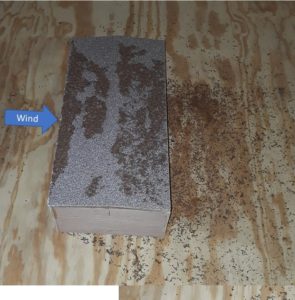Wildfire hazards
Our research group is interested in the flight of embers during wildfires. Ember storms can lead to spot fires starting well ahead of the main fire front and are also one of the leading causes of home destruction. Ali Tohidi in collaboration with Dr. Billy Bridges and I have developed a detailed statistical description of the size and shape of embers produced burning conifers. Ali then combined this data with a theoretical model for bent over fire plumes to develop a numerical model of ember lofting and transport. Ali also developed a set of wind tunnel experiments to provide the first detailed model validation data set for assessing the quality of ember flight models. Our next step is to investigate the impact of local topography and building shape on the accumulation of embers and resulting spot fire risk.
This work is currently being extended by Dac Nguyen who is investigating the conditions under which embers land and remain on the structures. This NIST funded work will improve our understanding of the risk of structural spot fire ignition in Wildland Urban Interface (WUI) communities. The photo below shows the result of a preliminary test in which a house roof was covered with embers and then exposed to the wind. The embers tend to congregate on the building leading edge away from the corners. Experimental work is done in the Clemson University Wind Load Test Facility
